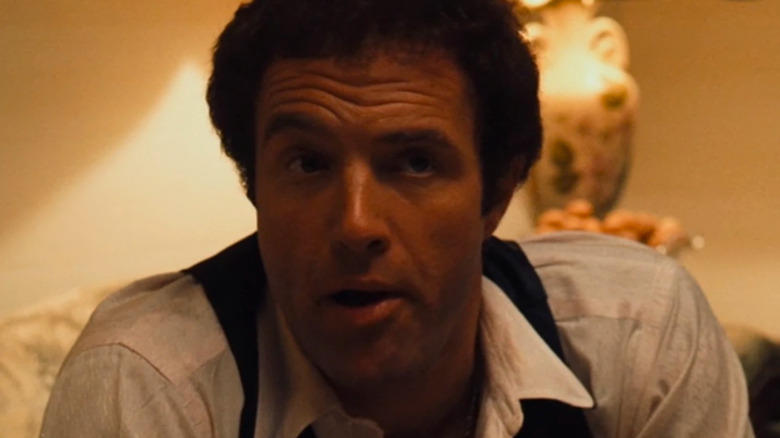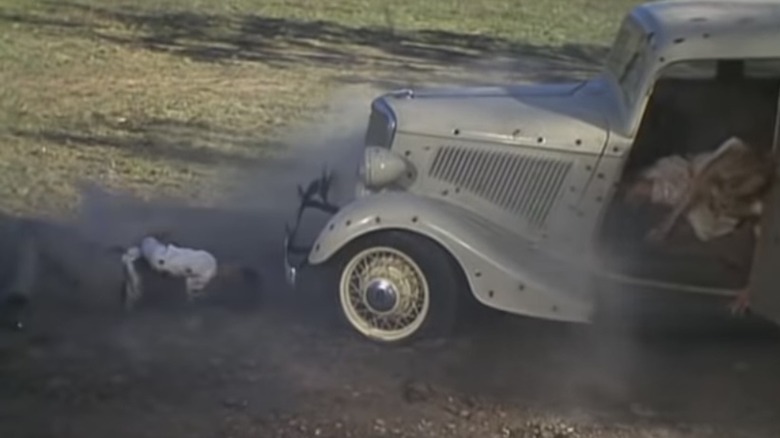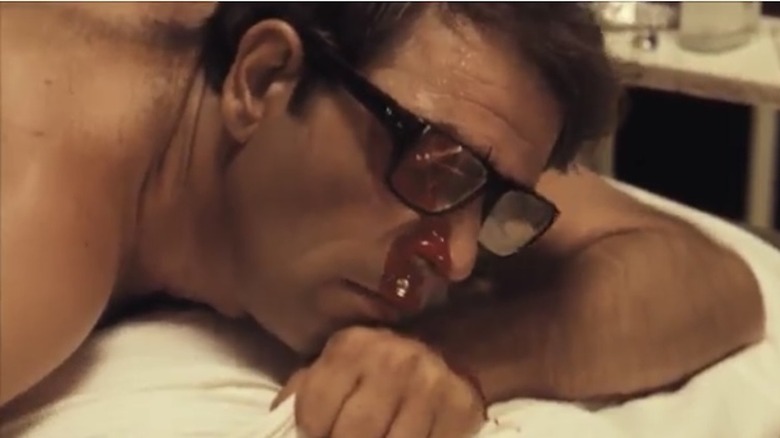How Bonnie And Clyde Inspired The Godfather's Most Famous Death Scene
"The Godfather" is known for its violent scenes, though its gore is never without purpose or imagination. The suspenseful pacing of music and pooling blood slowly exposed in Jack Woltz's bed makes the big reveal of the decapitated horse head all the more horrifying. And as Michael Corleone stands by as godfather at his nephew's baptism, he is baptized as the Corleone Godfather while the blood of the Five Families is spilled. One of the film's most iconic murders, the death of the eldest Corleone son, Sonny, wouldn't have existed without Arthur Penn's 1967 film, "Bonnie and Clyde."
In the first chapter of "The Godfather," the volatile Sonny Corleone, played with explosive passion by James Caan, intends to avenge his sister by beating up her abusive husband, Carlo. On his way to his sister's, Corleone gets caught at a toll booth on the Jones Beach Causeway and is killed by rival gangsters. The buildup to his death is short but intense: the toll booth worker drops his coin and draws back his door, and suddenly Sonny is aware that something is up and is ambushed by Barzini's men. He attempts to escape from his car but is showered with a rain of bullets. Blood spews through his teeth and he lets out agonizing screams while gunfire rattles his body. As Sonny lies on the ground, the gangsters send a gratuitous round of shots on his dead body and kick him in the head, a callback to Sonny's own excessive kick to Carlo after he beats him to a pulp. As it turns out, Sonny's death is reminiscent of the final scene in another famous gangster film that premiered just five years earlier, "Bonnie and Clyde."
Gang of gore
In "Bonnie and Clyde," the infamous couple, played by Faye Dunaway and Warren Beatty, drive down a dirt road and pull over to help a trucker on the side of the road. A sudden burst of birds flying out of the trees are the harbingers of death signaling gunfire from nearby bushes. We see Bonnie and Clyde flash each other one last look before bullets fire at them both, riddling their bodies with bloody holes. The scene unfolds in real-time at first and much like Sonny Corleone, we see Bonnie flailing inside her car as she is shot. But then Penn lingers on their deaths, drawing the scene out in slow motion.
The death scene in "Bonnie and Clyde" inspired "Godfather" director Francis Ford Coppola. In an interview with Terry Gross on NPR's Fresh Air, Coppola confesses that he was impressed with Penn's film and how the director handled violence:
"I thought that the effects, the depiction of violence in 'Bonnie And Clyde' always had an imaginative twist to it that it's one thing to see someone shoot someone, but if there's a detail – the way the blood turns into mist or the way, you know, something that you have – and I saw that in 'Bonnie And Clyde' – I thought was just absolutely wonderfully done."
Bloody shell
Those memorable special effects in "Bonnie and Clyde" were the work of Danny Lee, who was known for both his violent pyrotechnics and contributions to more than 50 Disney films. In a 2014 obituary, The Hollywood Reporter credited him as the first special effects man to master synthetic blood capsules and exploding electric shells to mimic gunfire entering a body:
"By doing so, he accurately captured the 1,000 rounds of ammunition that the real cops pumped into Bonnie Parker and Clyde Barrow in 1934. Lee punched holes in their car and filled them with squibs embedded in putty. When the police opened fire, the charges were set off. The fabric of Dunaway's clothes was thinned to showcase the maximum effect of the blasts on her."
Coppola looked up who had done the work on "Bonnie and Clyde" and called upon his own special effects man, A.D. Flowers, who was coming off his Oscar win for the 1970 Pearl Harbor Epic "Tora! Tora! Tora!"
Variety noted that like Lee, Flowers was a pioneer in his field:
"A technical innovator, Flowers created his own formula for movie blood for 'The Godfather' and then enhanced how it was used by creating a jacket that pumped out blood from a wound in diminishing spurts, as it would in real life."
Without the technical innovations of Lee and Flowers, paired with the keen eyes of directors Penn and Coppola, audiences wouldn't enjoy the artistic vision that sets apart "Bonnie and Clyde" and "The Godfather" from the rest of Hollywood's gangster movies.


